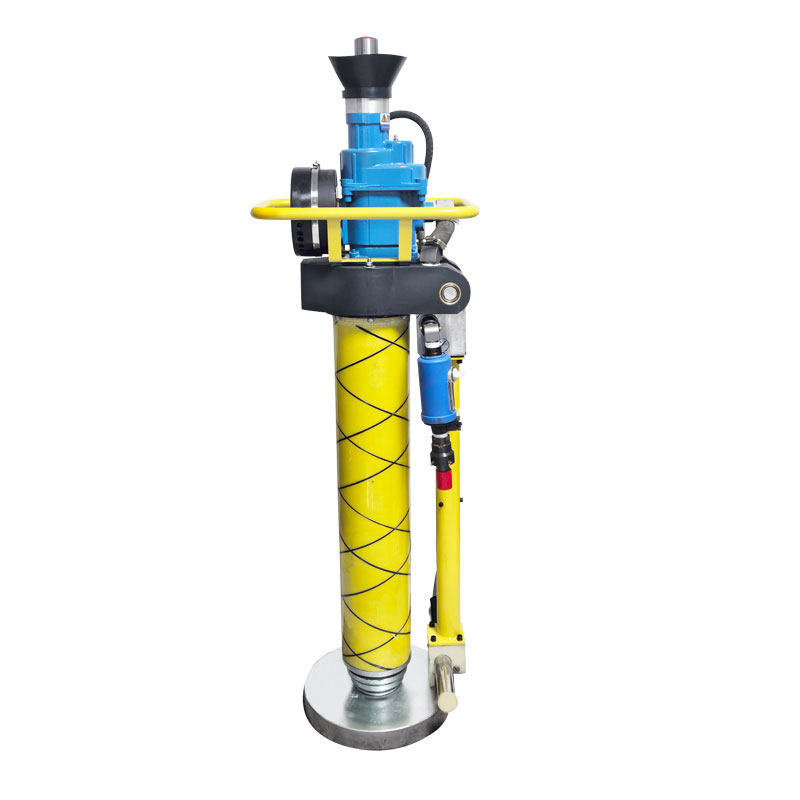Why Is a Reliable Pneumatic Anchor Rod Drill Critical for Geotechnical Stability?
2025-08-07
In geotechnical engineering, mining, and construction, ensuring the stability of slopes, tunnels, foundations, and retaining walls is non-negotiable. These structures face constant pressure from soil, rock, and environmental forces, making reinforcement a vital step in preventing collapses, landslides, and structural failures. Among the tools designed to deliver this reinforcement, the pneumatic anchor rod drill stands out as a cornerstone of safe and efficient operations. By combining the power of compressed air with precision engineering, these drills enable the installation of anchor rods—steel bars or bolts that secure soil and rock formations—with unparalleled reliability in harsh, high-stakes environments. For engineers, miners, and construction teams, understanding why a high-quality pneumatic anchor rod drill is indispensable can mean the difference between project success and catastrophic failure. This guide explores the critical role of these drills, highlights key features that drive performance, details specifications of our industry-leading models, and answers common questions to support informed decision-making.
Trending News Headlines: Top Searches on Pneumatic Anchor Rod Drills
- "How Pneumatic Anchor Drills Improve Slope Stability in Mining"
- "Key Features to Reduce Downtime with Anchor Rod Drills"
Why Pneumatic Anchor Rod Drills Are Essential for Structural Reinforcement
Power and Precision in Challenging Environments
Geotechnical work often takes place in harsh conditions: underground tunnels with limited space, steep slopes exposed to weather, or mining sites filled with dust and debris. Pneumatic anchor rod drills thrive here because their air-powered design eliminates the risks of electrical malfunctions (common in electric drills) or hydraulic fluid leaks (a hazard in hydraulic models). Compressed air delivers consistent torque and impact force, allowing the drill to penetrate hard rock, compacted soil, and concrete with ease. This power is paired with precise control over drilling speed and depth, ensuring anchor rods are installed at the exact angle and length required for optimal load-bearing capacity. For example, in tunnel construction, where anchor rods must be placed at specific intervals to prevent cave-ins, a pneumatic drill’s ability to maintain accuracy under pressure is critical to worker safety and project integrity.
Durability for Heavy-Duty, Continuous Use
Anchor rod installation is rarely a one-time task; projects often require hundreds or thousands of holes to be drilled, each demanding sustained performance. High-quality pneumatic anchor rod drills are built to withstand this workload, with rugged components like heat-treated steel cylinders, hardened alloy steel bits, and reinforced housings that resist wear from constant vibration and abrasion. Sealed air intake systems and dust filters prevent particles from entering internal mechanisms, reducing the risk of jams or breakdowns. In mining operations, where drills may run for 12-hour shifts, this durability translates to less downtime for repairs, keeping projects on schedule and reducing operational costs. Inferior drills, by contrast, may fail under continuous use, leading to delays that compromise both deadlines and structural safety.
Portability and Adaptability to Confined Spaces
Many reinforcement projects—such as tunnel walls, retaining walls, or slope faces—require drilling in tight or hard-to-reach areas. Pneumatic anchor rod drills are designed with portability in mind, featuring compact, lightweight builds (compared to hydraulic alternatives) that allow operators to maneuver in confined spaces. Models with ergonomic handles and balanced weight distribution further enhance maneuverability, enabling precise drilling even in overhead or vertical positions. This adaptability is crucial in scenarios like mining shafts, where space is limited, or on steep slopes, where stability and control are paramount. By combining power with portability, these drills ensure that no location is too challenging for effective anchor rod installation.
Cost-Efficiency and Low Maintenance
Pneumatic systems are inherently simpler than hydraulic or electric setups, with fewer moving parts and no need for complex electrical components. This simplicity reduces maintenance requirements: routine upkeep typically involves lubricating air lines, cleaning filters, and inspecting for wear—tasks that can be performed on-site with basic tools. Compared to hydraulic drills, which require regular fluid changes and seal replacements, or electric drills, which risk motor burnout in dusty environments, pneumatic anchor rod drills have lower long-term maintenance costs. Additionally, compressed air is often readily available on construction and mining sites, eliminating the need for specialized power sources and reducing setup time. For businesses operating on tight budgets, this combination of reliability and affordability makes pneumatic drills a practical choice.
Key Features to Prioritize in a Pneumatic Anchor Rod Drill
Impact Energy and Drilling Speed
Impact energy (measured in joules, J) determines the drill’s ability to penetrate hard materials like rock or concrete. For geotechnical work, drills with 50-100 J of impact energy are typically required to handle dense formations. Drilling speed, measured in revolutions per minute (RPM) or blows per minute (BPM), affects productivity—higher speeds reduce the time needed to drill each hole, but must be balanced with control to avoid overheating or damaging the anchor rod. A drill with adjustable speed settings allows operators to match the material, with slower speeds for precision in brittle rock and faster speeds for efficiency in softer soil.
Air Pressure and Consumption
Pneumatic drills rely on compressed air, so matching the drill’s requirements to the site’s compressor is critical. Most professional models require 90-100 psi (pounds per square inch) of air pressure to operate at peak performance. Air consumption, measured in cubic feet per minute (CFM), indicates how much air the drill uses—models with 40-80 CFM are common for anchor rod work. A drill with efficient air usage reduces strain on the compressor, lowering energy costs and preventing pressure drops during extended use.
Drill Bit Compatibility and Hole Diameter Range
Anchor rods come in various sizes, so the drill must accommodate different bit diameters. Look for a drill that supports a range of bit sizes (typically 16-50 mm) to handle common anchor rod specifications, from small diameter rods for light reinforcement to large rods for heavy-load applications. Quick-change chuck systems enable fast bit swaps, minimizing downtime when switching between tasks.
Ergonomics and Safety Features
Operators often use anchor rod drills for hours, making ergonomics vital to preventing fatigue and injury. Features like anti-vibration handles (which reduce hand-arm vibration syndrome risk), padded grips, and balanced weight distribution (ideally 25-40 lbs for portability) enhance comfort. Safety features are equally important: trigger locks prevent accidental activation, exhaust deflectors direct air and debris away from the operator’s face, and overload protection shuts down the drill if it jams, preventing damage to the tool or injury to the user.
Durability and Weather Resistance
Drills used in outdoor or underground settings must withstand moisture, dust, and temperature extremes. Look for models with corrosion-resistant coatings, sealed bearings, and rugged housings (e.g., cast aluminum or steel) to protect internal components. Dust-proof air intakes and water-resistant seals further extend the drill’s lifespan in harsh conditions.
Our Professional Pneumatic Anchor Rod Drill Specifications
|
Feature
|
JF-AR25 Compact Pneumatic Anchor Drill
|
JF-AR40 Mid-Range Pneumatic Anchor Drill
|
JF-AR60 Heavy-Duty Pneumatic Anchor Drill
|
|
Impact Energy
|
55 J
|
80 J
|
100 J
|
|
Drilling Speed
|
2,800 BPM
|
3,500 BPM
|
4,200 BPM
|
|
Air Pressure Required
|
90 psi
|
90 psi
|
100 psi
|
|
Air Consumption
|
45 CFM
|
60 CFM
|
75 CFM
|
|
Bit Diameter Range
|
16-32 mm
|
20-40 mm
|
25-50 mm
|
|
Weight
|
28 lbs (12.7 kg)
|
35 lbs (15.9 kg)
|
42 lbs (19 kg)
|
|
Length
|
31 inches (79 cm)
|
35 inches (89 cm)
|
39 inches (99 cm)
|
|
Chuck Type
|
Quick-change hexagonal
|
Quick-change hexagonal
|
Heavy-duty keyed chuck
|
|
Handle Design
|
Anti-vibration rubber grip
|
Padded ergonomic handle with vibration dampening
|
Dual anti-vibration handles with adjustable positions
|
|
Lubrication
|
Manual (pre-use oiling)
|
Automatic (integrated oil pump)
|
Automatic (variable rate oil pump with low-oil alert)
|
|
Safety Features
|
Trigger lock, exhaust deflector
|
Trigger lock, exhaust deflector, overload protection
|
Trigger lock, exhaust deflector, overload protection, noise reduction (92 dB)
|
|
Ideal Applications
|
Slope stabilization, light tunnel work
|
Mining shafts, retaining walls, medium tunnels
|
Heavy tunnel construction, deep rock reinforcement
|
|
Warranty
|
1 year
|
2 years
|
3 years
|
All our drills undergo rigorous testing, including endurance trials in simulated geotechnical environments, to verify their ability to withstand dust, moisture, and continuous use. We use premium materials, such as heat-treated alloy steel for critical components, to ensure longevity and consistent performance.
FAQ: Common Questions About Pneumatic Anchor Rod Drills



